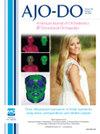下颌前牙在言语和动态微笑中的审美知觉。
IF 3
2区 医学
Q1 DENTISTRY, ORAL SURGERY & MEDICINE
American Journal of Orthodontics and Dentofacial Orthopedics
Pub Date : 2025-06-01
DOI:10.1016/j.ajodo.2025.01.015
引用次数: 0
摘要
前言:本研究通过比较外行人(LP)和正畸医师(ODs)对下颌前牙在言语过程中的审美感受。方法:拍摄I类咬合模型的“Czechoslovakia”发音和微笑。对动态微笑和语音图像进行提取和数字处理,以创建各种牙齿条件:理想对齐、下颌犬齿挤压、下颌切牙拥挤、倾斜下颌咬合平面、下颌切牙间隙和下颌切牙拔牙模拟。每组48名参与者(LP和ODs)使用视觉模拟量表评估图像。统计分析采用重复测量方差分析,显著性水平为5%。结果:评价者组间除动态微笑图像外无显著性差异。动态微笑图像得分最高,其次是整齐和水平的牙齿,两者都显示出显著差异(P结论:两组中语音图像的吸引力评分低于理想咬合。除了动态微笑图像评价外,LP和OD评价之间无显著差异。本文章由计算机程序翻译,如有差异,请以英文原文为准。
Esthetic perception of mandibular anterior teeth during speech and dynamic smile
Introduction
This study evaluated the esthetic perception of the mandibular anterior teeth during speech by comparing the assessments of laypeople (LP) and orthodontists (ODs).
Methods
A Class I occlusion model was filmed pronouncing “Czechoslovakia” and smiling. Dynamic smile and speech images were extracted and digitally manipulated to create various dental conditions: ideal alignment, mandibular canine extrusion, mandibular incisor crowding, inclined mandibular occlusal plane, mandibular incisor diastema, and mandibular incisor extraction simulation. Forty-eight participants from each group (LP and ODs) evaluated images using visual analog scales. Statistical analysis employed repeated measures analysis of variance with a 5% significance level.
Results
No significant differences appeared between evaluator group means except for the dynamic smile image. Dynamic smile images received the highest scores, followed by aligned and leveled teeth, both showing significant differences (P <0.05) from each other and the remaining images. Inclined occlusal plane and diastema images received the lowest scores. Group evaluations showed distinct patterns: ODs did not significantly differentiate between canine extrusion, crowding, inclined occlusal plane, and diastema images, whereas LP showed no significant differentiation between incisor extraction, canine extrusion, crowding, and diastema images.
Conclusions
Speech images received lower attractiveness ratings than ideal occlusion in both groups. No significant differences appeared between LP and OD evaluations except for the dynamic smile image assessment.
求助全文
通过发布文献求助,成功后即可免费获取论文全文。
去求助
来源期刊
CiteScore
4.80
自引率
13.30%
发文量
432
审稿时长
66 days
期刊介绍:
Published for more than 100 years, the American Journal of Orthodontics and Dentofacial Orthopedics remains the leading orthodontic resource. It is the official publication of the American Association of Orthodontists, its constituent societies, the American Board of Orthodontics, and the College of Diplomates of the American Board of Orthodontics. Each month its readers have access to original peer-reviewed articles that examine all phases of orthodontic treatment. Illustrated throughout, the publication includes tables, color photographs, and statistical data. Coverage includes successful diagnostic procedures, imaging techniques, bracket and archwire materials, extraction and impaction concerns, orthognathic surgery, TMJ disorders, removable appliances, and adult therapy.

 求助内容:
求助内容: 应助结果提醒方式:
应助结果提醒方式:


